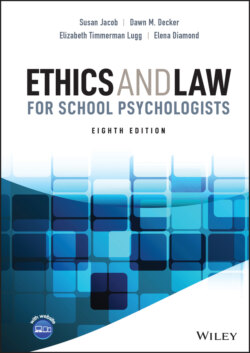Читать книгу Ethics and Law for School Psychologists - Susan Jacob - Страница 59
Vignettes
ОглавлениеEberlein (1987) and others have suggested that mastery of an explicit decision-making model or procedure may help the practitioner make well-reasoned ethical choices when difficult situations arise in professional practice. In this chapter, we introduced the DECIDE six-step problem-solving model developed by Diamond et al. (2021). The incidents that follow are included to provide an opportunity to practice the problem-solving model. At first, use of a decision-making model may seem quite cumbersome. However, it is important for practitioners to remember that ethical decision making “applies to almost everything psychologists do.” Over time, if such a problem-solving model is practiced regularly, it is likely to become almost automatic (Tryon, 2000, p. 278).
In the situations described, assume the role of the school psychologist and then follow a decision-making model to determine the course of action most appropriate. Compare your decisions with those of colleagues or fellow students.
1 A few months after Carrie Johnson was hired as the school psychologist in a rural school district, the district superintendent of schools asked to meet with her. During this meeting, he said, “You’ll be working closely with the principal at Pine Lake. Rumor has it he drinks a lot on the job. He’s been caught twice and fined for driving while intoxicated. I think he’s nuts, and we’ve got to get rid of him. Keep notes on what he says and does. I want a report later.” How should Carrie handle this situation? (Vignette source unknown.)
2 As part of her effort to build a strong working relationship with school staff and community members, Maria Delgado joined the Parent-Teacher Association (PTA) and regularly attends its meetings. During a public meeting of the PTA, a parent openly complained about the treatment her daughter was receiving in a world history class at a school where Maria is the school psychologist. The parent contended that the history teacher lacked mental stability and consequently was causing her child much anguish. How should Maria handle this situation? (Adapted from J. A. Bailey, 1980).
3 You and a fellow student (a friend) are placed at the same school for your first practicum experience. You are aware that she is a problem drinker, but thus far, she has been able to conceal her problem from the program faculty. You discover that your fellow student drinks before coming to practicum, and you have observed some erratic behavior and poor judgment at the practicum site. What should you do? What will you do? Why? (Adapted from Bernard & Jara, 1986).
